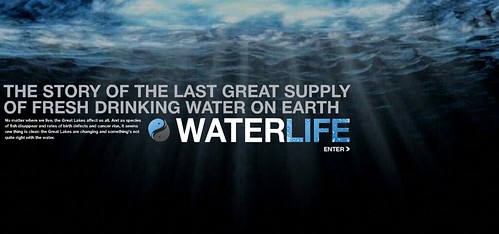
This blog post was written by my young colleague Tobi Elliott, who is helping me with several projects right now.
One of Canada’s recent successes in the interactive documentary universe is waterlife.nfb.ca, a site based on director Kevin McMahon’s documentary film of the same name. Waterlife the film (Special Jury Prize for a Canadian Feature at Hot Docs 2009) is a moving epic about the Great Lakes and the story of water itself: how it affects every part of our lives, and how it – and we with it – are under assault.
Its own creative endeavor, Waterlife the website is a co-production between Primitive Entertainment and the NFB. It picked up a coveted Webby award last April for Online Film and Video/Documentary, as well as the 2010 SXSW Interactive Activism Award, the BaKaFORUM City of Karlsruhe Prize for Multimedia, and a Canadian New Media Award for Best Cross Platform project in 2009.
Waterlife the website is considered a success, but how do you measure success in the online universe? Is it in page views, critical response, viewer comments, or what?
That is a very difficult question and I don’t really know what the answer is. Waterlife is considered a success probably for two reasons. One, there is a lot of public interest in it, and a lot of visits – about 600,000 visits – since it first went online a year ago.
Back when people like Magnus [Isacsson] and I started in documentary about 20 years ago, a CBC documentary would typically get 500 – 600,000 viewers, no problem. But that’s not true anymore. Although the film Waterlife has also been quite a success – it still screens almost weekly – it will not have reached a cumulative audience anywhere near 600,000. So that’s one measure: how many people come see it.
Another measure is how long they stay. In the case of Waterlife the website, when it first launched the average stay was seven minutes, but many users apparently stay around twenty minutes. To the web folks, this is a mark of success, but it does make you wonder about the quality of the experience vis a vis film.
It’s always difficult to measure, and it’s the same for a film: do you measure by critical success, by the fact that it really moves people and a lot of people go see it? By commercial success? All of these measures are relative and valid.

You write about Marshall McLuhen and his view that “the media’s touch is physical, and the feelings they provoke are real.” ** How do you think each medium – interactive media and feature film – feels to the audience? How do they perceive or react emotionally to them?
Broadly speaking, the film is really an entirely emotional experience. Some would say it’s more arty, or more of an intellectual film in some ways, but having been in many audiences, I’ve seen that the way they react to the film is really emotional. It’s a movie – it’s got music and pictures and people, and [the audience] reacts to the emotions it evokes in them.
I would say the website has an emotional component but also an intellectual one. The interesting thing about the web is that it’s engaging both sides of the brain all the time. It’s got pictures and sound, but it also has text. One of the advances in the Waterlife website is it relies much less on text than other websites do, but it still has text. That keeps that linear part of your brain engaged all the time.
Do you think each type of media appeals to different people?
I think they probably appeal to different people, because of the generational aspect, but they also appeal to people in different ways.
How did you combine the different platforms in terms of design, information-sharing, content? How did that work out?
The way they work together is that people who see the film and appreciate it, particularly anyone in an educational context such as teachers, students, are driven to the website by the film. There are two websites, and Ourwaterlife.com was set up to link people with activist organizations in their community, like Great Lakes United, Lake Ontario Waterkeeper, where they can go to take action. Waterlife.nfb.ca has that, but it’s kind of buried.
The film sends people to the website but I don’t think the website sends people to the film. It’s counterintuitive, the opposite of what we think websites are about. Websites were initially set up and used for film and television as advertising. Like flyers for your film.
But I don’t think that’s how they work, and in Waterlife’s case that’s not how it works at all… partly because the website is accessible to everyone in the world and the film’s available for screenings only in Canada and the U.S. It’s not as available as films in your living room that you can dial up via a website. We also know this because a lot of the feedback on Waterlife.nfb.ca comes from around the world and from places where the film is not showing.
What they share is their aesthetic, and they share a lot in their content. There’s no way of tracking the traffic between them but my sense of it is, there’s not a lot.
We went into this project thinking the website should be an adjunct and that it should drive people to the film. But Rob McLaughlin (Director of digital content and strategy for the NFB English Program), the driving force behind the website, said, “They are two different things. They share assets, there will be some back and forth traffic, but you have to approach it as two different things.” He was completely right and has proven to be over time.
** Refers to Kevin’s article “AERIAL PERSPECTIVE: A Window on Reality for the 21st Century,” printed in POV magazine, Spring/Summer 2007 issue, No. 66.)
————
Part Two of the interview to come: Kevin McMahon looks to the future.



